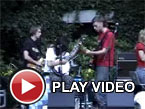Christina Kubisch, "Armonica"
 Invented by Benjamin Franklin in 1763, the glass harmonicais quite different than today’s mouth harmonica. Sound is createdby the movement of wetfingers along the rims of more than two dozen glass discs, arrangedhorizontally and moved using a foot-pedal. Apparently, playing the glass harmonica became a hip activity no doubtbecause of the enigmatic sounds its produces, compared at thetime to heavenly voices, perhaps also the cause of “serious nervousbreakdownsamong its mostly female players.”
Invented by Benjamin Franklin in 1763, the glass harmonicais quite different than today’s mouth harmonica. Sound is createdby the movement of wetfingers along the rims of more than two dozen glass discs, arrangedhorizontally and moved using a foot-pedal. Apparently, playing the glass harmonica became a hip activity no doubtbecause of the enigmatic sounds its produces, compared at thetime to heavenly voices, perhaps also the cause of “serious nervousbreakdownsamong its mostly female players.” Those who’ve heard people playing music with glass (not atall uncommon today), or anyone who’s worked a wet finger around the top of awater glass, will be familiar with the building blocks of a glass harmonica’ssound: steely, constant drones often touched by the sense of rushing or anxiousvelocity. Perhaps the way that the discsare arranged, or the fact that they are discs and not more concave shapes,produces, in the glass harmonica, a profoundly resonant exaggeration of thesounds produced by a wet water glass rim. The overtones created by concurrent drones are comparable to those of agong or large metal disc, minus the moment of striking impact and the variableof decay. Imagine sounds with theup-front urgency of sine-wave tones or tuning forks (the sound source forKubisch’s first release on Semishigure), but made strange and irregular by anobscured ringing, the glistening and wavering of vibrating metal.
Not part (from what I can tell) of one of the installationworks for which Kubisch is most famous, Armonicais almost one hour of glass harmonica recordings, unaltered by the artist. The silences and short fades that cut thehour into intervals give evidence to a kind of sectioning or arrangement byKubisch, a compositional intent that is nearly lost to the sense of awedirected at the instrument itself. It’simmediately hard to believe the sounds are non-manipulated until the noise ofthe player’s foot comes sneaking through like a message from the other side…thefamiliar one.
The higher-pitched discs sound at first like violins in aConrad drone formation, tactile in their suggestion of movement, but soonlifting to the front of the sound field with the nervous constancies of puretones, encompassing and impossible to let ride in the background. Lower-pitched discs operate within adistanced ringing similar to tuning fork notes, but always possess some form ofminute, rhythmic imperfection, perhaps due to the finger’s revolution aroundthe rim. When layered, these tinyundulations, like absent thought patterns, create bizarre,spatially-disorienting effects in conjunction with the more absolute sounds ofthe higher, rushing drones. The effectreminds me frequently of a more subtle version of the warm, warbly antique synthsound that Boards of Canada use so often. Kubisch’s piece, in contrast, is numbing and unforgiving; it’s closer inoverall feel to the work of Phil Niblock, despite the frequency of the breaksin the sound’s forward momentum. I feelthe recognizable sensations of mind-suspension combined with a very realgravity and heavy placementhere. Something about these sounds Ihave not pinned down makes them seem utterly alien but at the same time so sopresent. It’s driving me a bit (more)crazy, feeling like I could make more than a few friends with some 18thcentury harmonica-playing spinster freaks. Thank you, Christina Kubisch.
samples:



